This dispatch from the street comes from contributor/subscriber Ted Timmons
There’s been a lot of coverage of the SE Ankeny bikeway improvements and the city posted their plans, but I rolled through there Friday and noticed it’s actually becoming a reality. The diverter is diagonal with two exceptions: the center section is in line with the bike path and one side of the diverter had to be placed differently to accommodate a manhole cover.
Advertisement
Here are some pictures, it appears likely the city will use the same round concrete “barrels” that were used on Clinton.
– Ted Timmons, @tedder42
All photos by Ted Timmons, © 2015, licensed CC-BY 3.0.


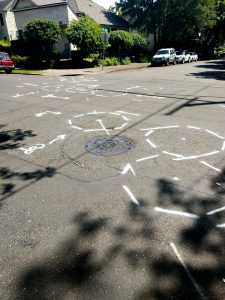
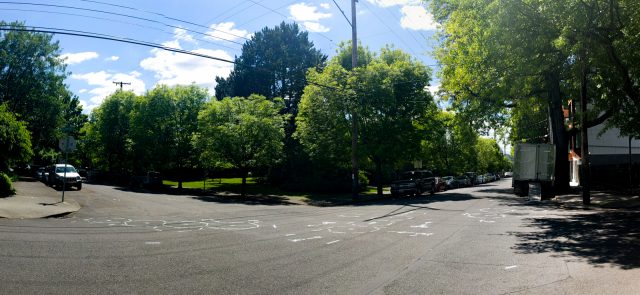
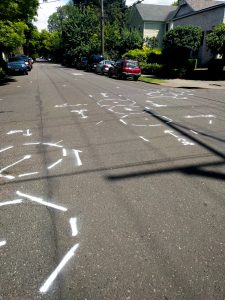


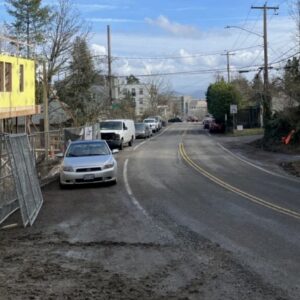
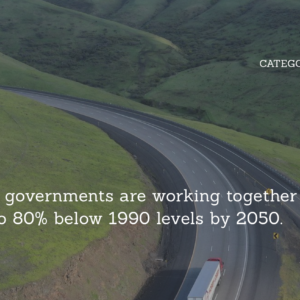
Thanks for reading.
BikePortland has served this community with independent community journalism since 2005. We rely on subscriptions from readers like you to survive. Your financial support is vital in keeping this valuable resource alive and well.
Please subscribe today to strengthen and expand our work.
looks like it will keep the cars out better than the Clinton one…
I saw the markings for the replacement plastic poles on the diverter on Ankeny today too.
great news! I rode down Ankeny yesterday and I am thrilled to see some progress. I really wish the City would get serious about 11th/Sandy, though. Traffic from south bound 12th can take the corner at Sandy at a very high speed come flying down the hill toward the intersection with Ankeny. IMO, it would be much safer to make the stretch of Sandy between 11th and 12th one-way ne-bound and convert the sw-bound lane to back-in angled parking. South-bound traffic on 12th would be routed down couch to 11th. Paikala (frequesnt commenter here) has suggested a roundabout at 11th and Ankeny which sounds great to me.
West of 12th and east of 28th are outside the current project limits due to budget constraints. Hopefully the project can be expanded since the gas tax was passed.
The temporary diverter (and one at N Holman/Mississippi) with use 2 foot tall concrete rings, repurposed from usual manhole construction, so will be less restrictive in terms of visibility.
great idea!
can you point me to what that looks like?
not yet.
my thoughts exactly. the current clinton ones make crossing it a blind cross in my car. yes i ride and drive either on or across clinton. the barrels restrict sight for passenger cars. that is not safe.
I can’t tell from the markings what it will actually be like. Can anybody elaborate? Will traffic be able to illegally bypass it if it wants, like that stupid one at SE 32nd & Clinton, or will it be more like a true diverter?
It’s diagonal across the entire intersection, there’s no way to bypass it with any reasonably-sized vehicle. Look at the third image.
so no taking your pedal-powered Rhoades Car or Surrey on it… looks like it will barely fit a standard 2-kid bike trailer…
This is why people are a poor judge of speed. Any idea you can see scale on a photo is without value.
The widest gap is six feet – the diagonal direction – but approaching from Ankeny the gap is 4-5 feet. A wider gap along Ankeny means the diagonal becomes wide enough for cars to pass through.
math.
I had the recent displeasure of riding Ankeny during afternoon rush last week. Ankeny is a currently a Greenway in name only. None of the major street crossings are signaled nor even have 4-way stops for drivers. There’s no way to safely cross Sandy, 12th, 20th, 28th, and worst of all, there’s not even a signal at Chavez! Does PBOT honestly expect people to dart though heavy motor traffic to cross Chavez? I also encountered some of the most aggressive driving I’ve seen in SE on Ankeny.
I’m glad that PBOT is making an attempt here, but a single diverter is nowhere close to the amount of fixes actually needed here. Fix the crossings too! At the very least, add stop signs for drivers on the busy cross streets instead of maintaining LOS for cars.
Agreed, Adam! You forgot MLK and 11th, though.
The six-way Ankeny/11th/Sandy intersection is pretty unbelievable. Six way intersections are dangerous even with full signals and this one has no traffic control devices whatsoever!
We should have a verb – Adaming something.
Did you participate in the Ankeny open house like you did with Clinton?
As has been clearly communicated, the budget for Ankeny is small, and the focus is on the highest volume section.
How much do a few stop signs add to the budget? That would work well as a stopgap measure until funding for full signalization comes in.
And yes, I left feedback on Ankeny via the online survey. Simply saying “well the budget was small and you didn’t show up in person to the open house” doesn’t invalidate the safety concerns.
‘a few stop signs’ on Collector streets and Major City Traffic streets where no history of crashes exists? Major delay on major streets for the convenience of one mode of travel – seems like we’ve been down that road before.
Yep, sounds exactly like maintaining Level of Service for motor vehicles.
our roads are littered with traffic signals. show me the data.
when two neighborhood collectors intersect does the city expect motorvehicles to dart across an un-signaled intersection when there is a gap in traffic? it’s almost as if you are arguing that level of service on a major bike route is less important than level of service on a neighborhood collector.
It’s like you’re arguing that there is a level of service problem at the Ankeny crossings at 12th, 20th and 28th.
NCHRP 562 analysis says there is not.
level of service is not the same as safety.
if every bike trip mattered just as much as every car trip when it comes to intersection LOS we would have far more bike-specific signals in pdx.
there is, of course, also a safety argument and a “not meeting our transportation goals” argument for signals by default at all neighborhood Greenway collector/arterial intersections.
Soren,
you would spend Portland to death.
‘signals by default at every collector/arterial”?
(BTW Portland does not have an ‘arterial’ classification)
Full signals cost $250k each, Hybrid beacons around $150K each.
Why does Bryant at Vancouver need a full signal?
Why does Going at 15th need a signal?
Going at 33rd?
Siskiyou at 15th?
Ankeny at 20th?
Paikiala, putting at least some sort of crossing treatment (above a painted crosswalk) at locations like that seems to me as what’s needed for comfortable travel at congested times for the “interested but concerned.” In my opinion, RRFBs would be fine, as long as there is a button that people on bikes can press from their bikes without contortions (unlike, say, SE 52nd at Woodward).
32% of adult Portlanders* are interested in biking for transportation but don’t now, and feel uncomfortable riding. Doing what’s necessary to make them feel comfortable seems to me like the only way that we’re going to meet our bike mode share and climate goals. And yes, we will need more funding to be allocated to active transportation if we’re actually going to achieve those goals.
*http://web.pdx.edu/~jdill/Dill_VeloCity_Types_of_Cyclists.pdf , p.21
Paikiala, I think rapid flash beacons and in some cases stop signs could be used.
I also think the city should lobby the state to revise the ORS so that people cycling in crossbikes have the same legal rights as a pedestrian in a crosswalk.
Clinton Street has stop signs at the collectors and a full signal at Chavez. Has this caused “major delays”?
Clinton only has one internal collector – 26th. An offset intersection where stop signs serve a different purpose. 20th is Local Service.
Does that stop sign at 26th cause major delays? What about the full signal at Chavez?
Adam,
Perhaps you forget that signals are green for each direction at least45% of the total signal cycle.
Stop signs are red 100% of the time for 100% of the approaching traffic 24/7/365.
math.
I would also like a definition of ‘dangerous’. Since it means different things to different people, knowing how you define it can help everyone else judge your position.
Here’s mine: crashes – actual reported crashes.
2008-2012 (last reviewed)
1 ped, one bike crash at Grand.
Ankeny at Sandy/11th: zero bike or ped involved crashes.
1 at 20th
2 at 28th
zero at Chavez
worst location:
4 at 13th and Ankeny
If I feel unsafe riding a bike there, then it’s dangerous. When people are deciding to start riding, they don’t go check statistics on how many crashes were on their route, they go by how safe they feel riding it. This is a problem inherent to having engineers design our roads, not sociologists. 😉
That’s not to say the data isn’t useful – it’s certainly a good idea to take a data-driven approach to safety. However, no matter how safe a road is in reality, if it doesn’t feel safe, then people won’t use it. Good cycling infra should not only be safe, it should look and feel safe too. This is a significant part of design which PBOT seems to continually fall short on.
“If I feel unsafe riding a bike there, then it’s dangerous”
Wow. I’ll just pretend you meant to add “to me” at the end of that sentence.
But you feel unsafe riding a bike practically everywhere.
i am an adrenaline junky who enjoys riding arterials and i still believe that anyone who feels safe riding amidst distracted primates operating multi-ton machines is in denial.
Safety is a spectrum, not a binary safe or not safe. For example, I feel safer on Clinton where the diverters were put in than the segment without diverters. But I don’t feel 100% safe even in the former, since as soren points out, you’re still sharing space with motor vehicles. The places in Portland where I feel close to 100% safe are on separated cycleways and bike paths, free from motor traffic. I am not the only person on Portland that feels this way.
Well, given that Adam shares that characteristic with the vast majority of the good chunk of Portlanders who would consider riding for transportation but don’t* I think his preferences might be pretty relevant to crafting public policy designed to increase the number of people biking in Portland.
*http://web.pdx.edu/~jdill/Dill_VeloCity_Types_of_Cyclists.pdf, p.21 – 39% of Portlanders both don’t ride regularly for transportation and aren’t “no way, no how”; out of that, 32.1% are in the “interested but concerned” category which means they are uncomfortable but interested.
The driver compliance at 39th is surprisingly good, though. I have ridden Ankeny for years and rarely have to wait longer than 20 seconds when crossing 39th. 20th can be pretty bad to cross at times, and 28th has really poor site lines.
Agreed, I have probably biked 75% of the days to work the last four years and it is almost rare that a driver does not stop to let me through. I think they realize there is no rush to get to the red light 200 feet away.
I agree the Ankeny & Sandy crossing is a hot mess. And this street is supposed to be safe enough for a six year old to ride.
Um…… Yeaaaaaahhh…..
Artificially lowering the lowest age of design doesn’t help your argument.
It’s 8-80, not 6-60 😉
Hello Adam,
I’m not sure you’re being bold enough with your proposals. Having read many of your frequent, negative comments here on BP, to say nothing of your entertainingly distraught Twitter feed (who doesn’t love a good prediction of the imminent end of the United States?), I can, by your own standards, predict your dissatisfaction with your own solutions to Ankeny. Stop signs? Signals? You more than anyone know the tendency of drivers to cheat these traffic controls. A truly bold suggestion that puts cyclists first would be gates at all major cross streets. One car at a time will be allowed through the gates, only after a bell has chimed to notify passing cyclists of an entering vehicle. Also, for the vehicles waiting in the queue, a sign flashes that reads, “You should ride a bike rather than drive when in an urban environment. You should not own a car. The city does not prioritize vehicle traffic.” I think you’d be comfortable with this innovative solution, at least for a while.
As someone who rides a bike on Ankeny every day, I take issue with your passing judgement and your insistence on steering every conversation towards a larger, more ambitious, attainable-but-perhaps-overwhelming vision. It is exhausting and unproductive. I am an advocate for cycling, and yet you discourage me by relentlessly stating how things aren’t good enough for your liking. Who am I to rejoice over the upcoming installation of a traffic diverter if I don’t also despair over the work yet to be done?
You tend to rebuff all criticism that your actions haven’t spoken as loudly as your words. I think you make fair points that you can’t be everywhere all the time. But I also wonder how long you’re going to be satisfied finding dissatisfaction with the way this city does things. How long are you going to troll BP’s comment section and maintain a frighteningly critical and alarmist Twitter account before you tire of it? Wouldn’t you be better served finding a productive use of your energies, so you don’t burn out and give up altogether? Portland needs passionate people like you. But you do all of us a disservice by directing your passion in a negative, despondent way.
It is my firm belief that small, incremental changes will never be enough. We need comprehensive changes, not one single diverter. If that comes off as never being happy with what’s done here, it’s because what’s being done is not nearly enough. I am simply basing my views on what’s done in real cycling cities overseas, and what we manage to call “bike infrastructure” here is laughable compared to what many other cities and countries have done. If you’re happy with this status quo then that’s your prerogative. But how are we going to convince the 93% of people who don’t ride (very few of which post here or bother to show up to open houses) that cycling for transportation can be fun and easy? How are we going to convince people that it’s okay to walk down outer Division without fearing for their lives? How will we reach the point where no one is endlessly dying on our streets? These goals will never be solved with just a few diverters here and there. What am I supposed to do? Pat the city on the back for doing what I and many others would consider to be the bare minimum? Praise the status quo? We can and should be doing better, and I’m happy to continue fighting for what I know is the right choice. If you don’t agree with me, then you’re free to ignore me.
How can anyone managed to ignore you, when your comments can be 20% of the comments on a story?
Adam, do you ever feel safe anywhere? I too read a lot of your comments, some I agree with, other comments come off as overly passive aggressive when people don’t agree with your vision. I know everyone can’t be the fearless rider but I really think no city in America is up to par when it comes to biking infrastructure. Montreal, Vancouver are great cities to ride but neither of them compare to cities like Amsterdam, Copenhagen, Paris, Munich, etc. I feel someone with your passion should work their way up the city channel, get your voice heard, be the voice of the people. You said it best, not a lot of people are reading bikeportland but just imagine for a moment if you took your ideas, thoughts, frustrations where it matters and not just here. My two cents.
Thanks for your input. Yes, I feel safe riding anywhere that’s separated from motor traffic or has very low volume. Or riding in a large group. Unfortunately, I have to ride during peak hour both directions, so my ride is stressful morning and evening. Clinton Street is usually fine. I prefer separated cycleways like SW Moody, though.
I think there’s a lot of nuance lost when posting online with just text. What I see as firmly standing up for what I believe may come across to someone else as being “passive-aggressive”. Admittedly, I do inject a bit of sarcasm but that’s just my personality I suppose.
I would love to work my way up the city channels, and am certainly trying by working with BikeLoud and running for RNA board. However, it’s easier said than done, while posting on Bike Portland is just easy. I’m trying to do both. 🙂
Quelle horreur!!!
I think Adam annoys some people because at some level they believe that uppity cyclists who *demand* transportation mode equity are “making them look bad”. I don’t agree with Adam on many points (i think a door-zone-free bike lane is perfectly fine in many contexts) but I appreciate that he is pushing the Overton window away from accommodation and business as usual towards “build it @#$%ing now”.
Yep! Especially since the city has stated goals for cycling and a bike plan that they are ignoring. Portland leaders already made those bold plans, but are not acting upon them. I’m simply asking they follow their own guidelines. 🙂
You said ‘ignoring’. Back it up with examples, since evidence is probably lacking.
Perhaps not ignoring, but “making progress towards too slowly to actually achieve the goals therein,” for sure. Bike mode share in 2010: 6%. Bike mode share in 2015: 7%. Bike mode share goal set in 2010 for in 2030: 25%. The goal is 19 percentage points increase in 20 years (to 15%). In five years, we have increased ONE percentage point.
Yes, we have recently increased the pace of funding bike projects. But do I think that if we continue at the current pace, we will hit 25% by 2030? Not even close.
I think it is possible.
The 6%-7% you cite is a city average. In some inner east side neighborhoods the share is 18% already.
Boosting east of 82nd to 10% and west of 45th to 30% gets us very close.
The east half of Portland is where the greatest potential gains can be achieved, IMO, but also the most costly.
Equity says to spend our scarce dollars where they are needed most, not where it is cheapest to invest.
I think it’s possible, but would need more funding and political will than is currently manifest. East Portland should definitely be a priority based on equity (East Portland resident here!). Many of the currently-planned E PDX greenways (e.g. 4 M’s, 130s) include sections where diversion is very hard due to an unconnected street grid yet motor vehicle volumes are high. The current default for these sections looks to be parking removal on one side of the street and 5- or 6-foot bike lanes. That’s not an infrastructure/street type combo that is going to get interested but concerned riders out on their bikes in droves.
Another type of comfortable bike infrastructure that is a good fit for East PDX is protected bike lanes on major streets. Halsey/Weidler is a good thing, but it’s only a ten-block stretch. The 122nd project could be huge, but as far as I can tell, has made no progress.
And if you think we don’t really need the interested but concerned to be comfortable in order to get to 10% mode share in E PDX, – consider the much greater average distance to destinations in E PDX. Many of the people who would be “Strong and Fearless” or “Enthused and Confident” work or go to school too far away from their home for biking to be a practical option. E-bikes make it easier, but cost and knowledge are a real obstacle for low-income and immigrant populations – and a 10-mile-each-way commute like mine is still not all that easy even on an e-bike.
How are we going to get to 10% mode share in East Portland by 2030 at this rate?
“In five years, we have increased ONE percentage point.”
and that 1% was within the margin of error.
I ride Ankeny everyday and have for years. The places were cut through traffic is the worst is not addressed by this diverter. I more often see cut through traffic on Davis East of 60th, turning north off Burnside at 42nd, cental catholic kids/staff commuting to school on the bike lane from 39ths on up.
I do think that Ankeny is pretty safe (or at least has been). Only one near death experience at Sandy which chastened me. However there are now thousands of new residents living down on lower Burnside and the street is changing fast.
Hopefully this and future additions will keep it safe.
Lahar,
How is ‘Davis east of 60th’ the Ankeny greenway?
Davis/Everett is a separate and parallel route.
Davis and Everett work as an extension of the Ankeny Greenway east of 41st, where Ankeny dead ends at the T intersection. Most people heading east turn north, cross Burnside and then turn east on Davis and Everett until it ends in the 70’s.
One thing to consider. The stretch of Ankeny between 20th and 28th will have added about 175 new housing units between 2014-2017. This should increase the number of people using bikes (yeah!) but also will increase the number of cars on the street (boo!). I won’t be surprised if we are talking about conflicts on this stretch in the coming years.
Right, and this is why it’s important to take a proactive approach (how can we ensure this road stays comfortable for cycling?) instead of the current reactive approach (there’s too much motor traffic, let’s add a diverter where needed).
Adam,
You’re advocating for spending scarce tax dollars where a problem does not currently exist, on a route that, by most standards, is working fairly well, when there are people in Portland without sidewalks, improved bike routes, or enhanced crossings (where you don’t live/work/ride)?
…….
Paikiala, I think Adam is (or should be) making a case for *increased* dollars allocated to transportation so that we can do all of the above.
And, who is making the standards included in your “most” standards? Given that the City used a standard from North America to define the 2000 vehicles per day threshold for greenways, are we looking only to North American traffic engineers? Are these the standards-makers who can help us create a safe, healthy, low-carbon transportation system as per the City goals or should we be looking to people who have actually created safe, healthy, low-carbon transportation systems?
I think the important standard is the mode-share goal in our climate action plan. If you want people to *choose* something besides driving alone, you have to do better than waiting to count how many people die per year on a given street. Portland needs to make it easy to choose to ride a bike instead of driving or 25% share won’t happen (making it difficult to choose to drive a car is probably the better bet.) “Too much motor traffic” on a neighborhood street could be easily defined as any traffic where A or B is not within a few blocks. Scarce tax dollars will continue being shoveled into a network of potholes until morale improves.
the economic and health impacts of increasing automobile congestion alone make comfortable bike infrastructure (and pedestrian infrastructure and funding of mass transit) an imperative.
Alex,
‘standard from North America’?
PBOT set the standard for auto use at 1,000-1,500. 2,000 per day is an OR Legislative standard only for a speed limit.
NACTO sets the standard for shared use at 3,000 cars per day.
PBOT set the “standard” at 1,000-1,500 per NACTO yet only said it would *do* something if a greenway went over 2,000. Which, albeit, is better than NACTO’s 3,000 – but what if we set our standard to be best-in-class? Vancouver, BC has diverters every 5 to 10 blocks, amazing signage including bike symbols on the greenway’s street sign at intersections with major streets (in order to inform and lure in people who currently don’t bike), and consistent signalled crossing treatments at every potentially uncomfortable intersection on their bike boulevards. We don’t. Even on new greenways.
We were an early leader in bike boulevard development, but if we base our standards going forward off of national standards and state law, we’ll never be a leader again.
one person’s scarcity, is another person’s misallocation of funding. a 5% cut to public safety would go a long way to making our roads safer.
Any word on whether this has been constructed yet? It’s now July, so I’m curious!